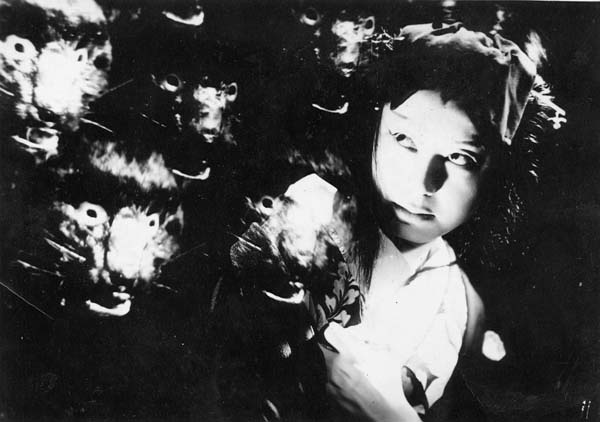The Ghost Cat and the Mysterious Shamisen
20 Nov 2011 – 24 Nov 2011
This rare screening of The Ghost Cat and the Mysterious Shamisen, an early chiller especially subtitled for Zipangu Fest, presents a rare chance to experience one of Japan's few surviving prewar horrors, a genre that was soon to be suppressed by the increasing state censorship of the wartime years. A quintessential example of the period "ghost cat" (bakeneko or kaibyo) movie, this was one of at least six such titles released by the studio Shinko Kinema between 1937-40 featuring Japan's first scream queen, Sumiko Suzuki. Here she plays
Mitsue, the possessive onna-kabuki actress betrothed to apprentice shamisen player Seijiro. When one day Okiyo, a beautiful young girl of samurai class, is led to Seijiro's house by his lost cat Kuro, she becomes besotted with him. Dark jealous passions are invoked in Mitsue, which are intensified when Seijiro gifts Okiyo his precious shamisen. The cat is the first to suffer at the end of Mitsue's hairpin, but returns from the grave to assist Okiyo's younger sister Onui avenge her sister's murder. Director Kiyohiko Ushihara employs an arsenal of dark
double exposures, slow motion sequences and specially-developed lenses to convey this dark, uncanny tale.
Director Bio
Barely known in the West and with little of his work surviving, Kiyohiko Ushihara (1897-1985) was one of Japan's leading directors of the silent period, directing some 70 titles for Shochiku from 1921-30, with 9 months spent studying filmmaking in Hollywood under Charlie Chaplin during 1926. After scripting the studio's groundbreaking Souls on the Road (1921), he made his debut with The Mountains Grow Dark (1921), with standout work including a two-part adaptation of Victor Hugo's Les Misérables set in ancient China released in 1923, and Marching On (1930), a war spectacular about biplane pilots written by Ozu's scriptwriter Kogo Noda and starring Kinuyo Tanaka. From 1930 to 1933 he directed a number of films for Nikkatsu, before moving to Shinko Kinema, where he remained after it was merged with Daito to form Daiei. Ushihara's postwar work is sparse, although includes A Popular Man in Town (1946), whose story modelled strongly on Frank Capra's Meet John Doe (1941) bore the hallmarks of his strong Hollywood influence, while Forever My Love (1952) was a U.S.-Japanese co-production, co-directed with Paul Sloane, about an American sergeant who falls in love with a Japanese girl.
From the collection of the National Film Center, The National Museum of Modern Art, Tokyo
Dir. Kiyohiko Ushihara, Japan 74mins, 1938, Subtitled
Cast: Sumiko Suzuki, Shizuko Mori, Kinue Utagawa, Shinbachiro Asaka, Mitsoku Mori



